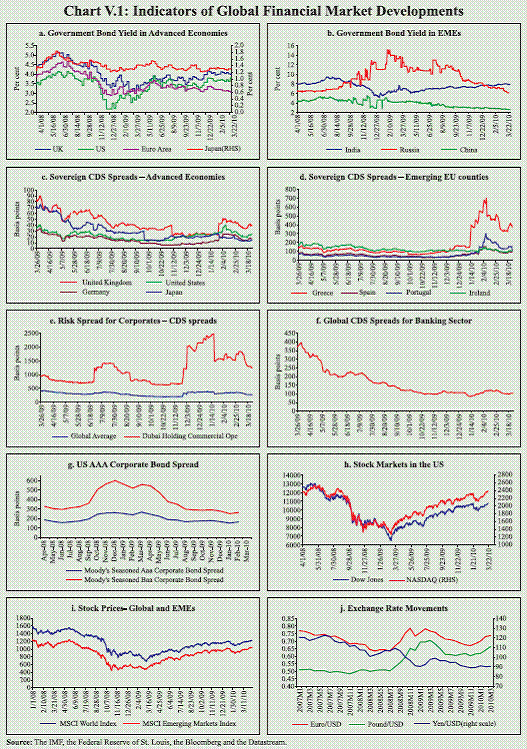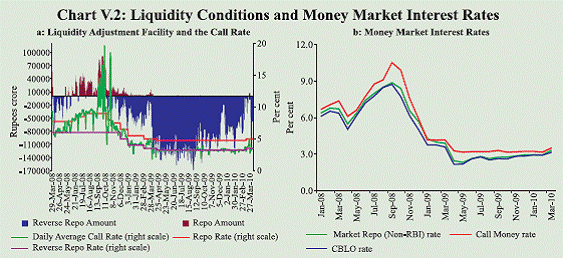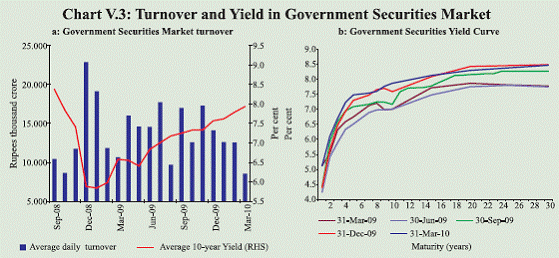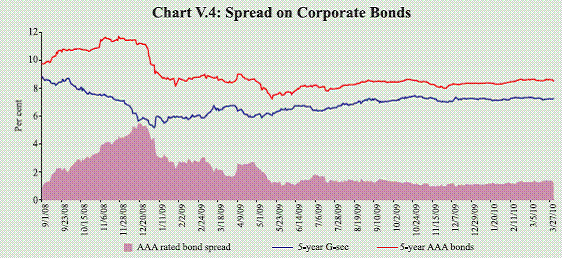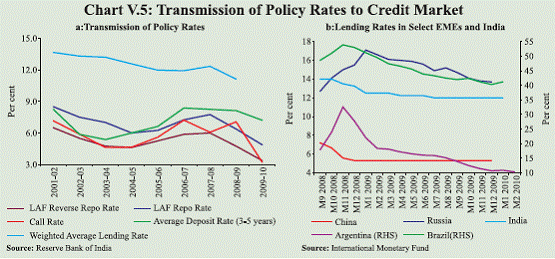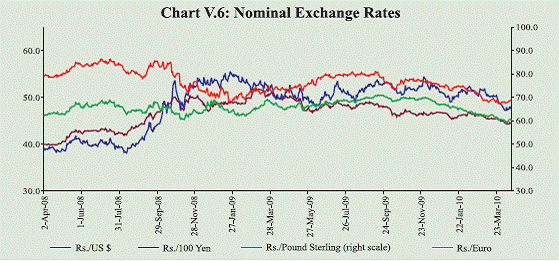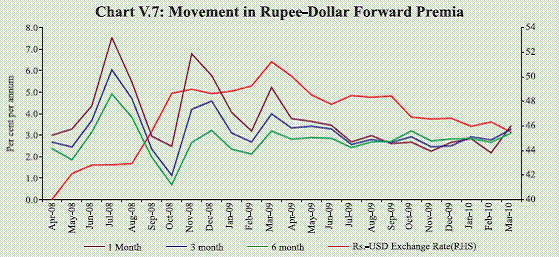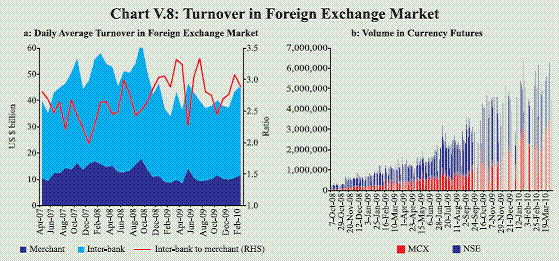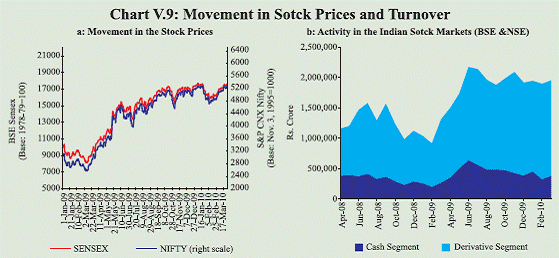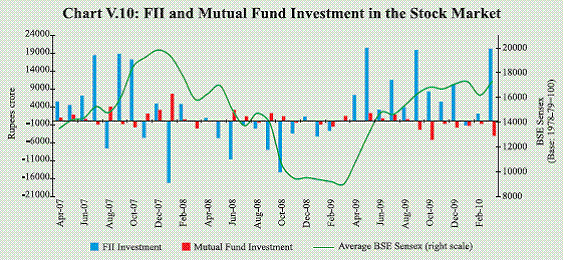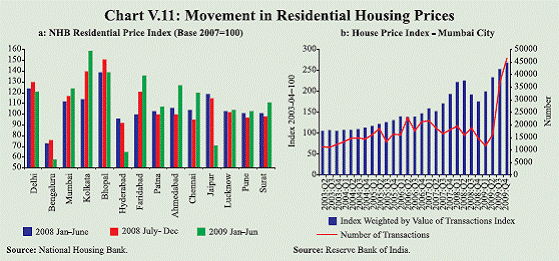V. Financial Markets - આરબીઆઈ - Reserve Bank of India
V. Financial Markets
The global financial markets witnessed further stabilisation with firmer indications about the strength of the recovery but with concerns about fiscal conditions as reflected in sovereign risks. Domestic financial markets remained stable. While the persistent surplus liquidity conditions kept the money market interest rates low, the medium to long-term yield on government bonds increased, reflecting the concerns relating to the size of the borrowing programme and inflationary conditions as well expectations about the monetary exit. The credit market conditions improved with a turnaround in the demand for credit from the corporate sector as well as better transmission of policy rates to the deposit and lending rates, though with lags. Asset prices, in terms of stock prices as well as residential housing prices, exhibited significant rise. The upward pressure on the exchange rate continued, reflecting the revival in capital inflows. V.1 Uncertainties about the path of future global recovery and risks arising from large sovereign debt continue to threaten the return to stability in the international financial markets. These developments in the global financial markets transmitted to the domestic financial markets by way of sporadic volatility in stock prices and the exchange rate. The domestic financial markets faced concerns emerging from the large fiscal deficit, despite the beginning of exit, and the inflationary expectations stemming from high headline inflation, which affected the government bond market. The transmission of lower policy rates to the credit markets improved through lower lending rates, though with lags. The flow of credit to support the recovery in growth improved in recent months, while availability of resources from non-banking sources also increased. Asset prices increased at a relatively faster pace in the recent period. With the turnaround in capital inflows, the exchange rate appreciated. International Financial Markets V.2 The global financial markets during 2009 exhibited significant stabilisation, despite the drag from the global financial crisis. Although financial markets were marked by intermittent volatility, mainly arising from the uncertainty regarding the shape of the global recovery, the risks in the global financial markets declined for most part of 2009, as stronger signs of global recovery became visible. The sovereign risk concerns, however, dominated the financial markets. Two major events i.e., the Dubai World debt standstill and the sovereign debt problem of the East European countries, mainly Greece, posed another bout of risk to the financial system towards the end of 2009 and beginning of 2010, which led to greater volatility in the international markets. V.3 In the aftermath of the global financial crisis, the high debt levels in the advanced economies – an outcome of bailouts and unprecedented fiscal stimulus – have created adverse market expectations about sustainability of such debt levels and exerted pressures on the government bond yield (Chart V.1a). With signals from the major central banks in the advanced economies that interest rates may remain low for some time, the bond yields have somewhat moderated towards the end of the year. The government bond yields in EMEs witnessed broadly a moderating trend, excluding India (Chart V.1b). Recent events, i.e., Greece’s sharp revisions of budget deficit from 3.7 per cent to 12.7 of GDP in 2009 and the Dubai World default, have renewed risk aversion in the sovereign bond markets (Chart V.1c and d). Besides Greece, the other Euro area countries such as Italy, Portugal, Ireland and Spain also seem to be under stress due to high public debt. While Ireland is already on fiscal adjustment, the contingent liabilities from the banking sector still loom large. V.4 The US AAA-rated corporate bond spreads declined by about 100 basis points between January 2009 and March 2010 (Chart VI.1g). In the aftermath of the Dubai World debt default, however, the credit risk repricing for corporates was evident from the increase in global credit default swap (CDS) spreads for the corporate sector (Chart V.1e). In fact, activity in the CDS market in advanced economies increased significantly as investors reassessed their exposure to sovereign risks. The CDS spreads for the banking sector, which had shown sequential drop in 2009 due to improved bottom lines of the banks, witnessed pressure in Q1:2010 as the market concerns of sustainability of sovereign debt in many advanced countries and EMEs impacted on the risk perception towards the banking sector as they accumulated a large portfolio of government bonds in their balance sheet (Chart V.1f). V.5 A significant reduction in investor risk appetite to both the advanced economies and the EMEs was reflected in large gains in equity prices in 2009, which have been sustained in 2010 so far. The US stocks recorded gains of about 42 to 56 percent between March 2009 and March 2010 (Chart V.1h). Although the gains in equity prices in both the advanced economies and EMEs were marginal in Q1: 2010 over Q4:2009, overall the advanced economies’ stock prices gained by 52 per cent between March 2009 and March 2010, while the EMEs recorded even higher gains of 78 per cent, reflecting the uneven pace of global recovery (Chart V.1i). V.6 The gains in EME asset prices were aided by a number of factors such as robust economic recovery, reduced risks, low interest rates in the advanced economies and capital inflows in search for higher yield. The rising short-term capital flows to EMEs raised concerns about their adverse impact on the exchange rate and liquidity management, prompting some countries to impose variants of Tobin tax. Brazil imposed a 2 per cent tax on foreign capital (invested in domestic equity and bond markets) in October 2009 and a further 1.5 per cent tax on certain trades involving American Depository Receipts (ADRs). Taiwan also prevented flow of foreign funds into time deposits from mid- November 2009. V.7 In the foreign exchange market, the depreciating trend of the US dollar was reversed during Q1 of 2010 (V.1j). The US dollar generally appreciated against major currencies like the euro and pound sterling during the quarter, buoyed by positive economic data from the US. However, despite the strength exhibited by the US dollar against major currencies during Q4 of 2009, it depreciated against the major currencies as also against the currencies of EMEs during the year as a whole (see Table V.1).
V.8 The stronger signs of global recovery taking hold led to reduction in risks in the international markets, which also favourably impacted the domestic equity markets during the major part of 2009. Reduction in risk perception towards EMEs along with continuance of low policy rates in the advanced economies for the extended periods, led to revival in capital flows to India, which in turn contributed to significant gains by the equity markets and at the same time put appreciation pressures on the exchange rate. Nevertheless, since the last quarter of 2009, the global shocks from Dubai World standstill on debt payments and sovereign debt concerns spreading from Greece to other East European countries, have impacted the domestic markets in terms of higher volatility in stock prices and to some extent the exchange rate. Overall, the impact of such global shocks remained contained and transient; the various segments of the domestic market functioned in an orderly manner, with increasing volumes in activities. Domestic Financial Markets V.9 The domestic financial markets during 2009-10 were characterised by certain major trends, such as prevalence of comfortable liquidity conditions in money markets despite large government borrowing programme, MSS unwinding in alignment with the borrowing programme to contain pressure on yield, call rate remaining low and around the lower bound of the liquidity adjustment facility (LAF) corridor, rising pressure on medium to long-term government bond yield, appreciation of the rupee amid a two-way movement, and substantial gain in asset prices, in terms of both stock and housing prices (Table V.2).
Liquidity Conditions V.10 The intra-year dynamics of liquidity conditions reflected the calibrated policy response to the evolving macroeconomic and financial market environment, interspersed with the impact of quarterly advance tax outflows. The surplus liquidity in the domestic markets, partly induced by unwinding of the MSS balances, prevailed during almost the entire financial year 2009-10. The key drivers of liquidity during the first half of 2009-10 were open market operations (OMO) to manage the Government borrowing programme coupled with MSS unwinding. The total liquidity released during 2009-10 through the unwinding of MSS and auctionbased OMO purchases amounted to Rs.1,42,827 crore. The surplus liquidity, however, declined somewhat in the second half of 2009-10 on account of relatively lower MSS redemptions, absence of OMO auctions, apart from the CRR hike in February 2010, which absorbed primary liquidity of around Rs.36,000 crore from the system. The surplus liquidity declined further on account of quarterly advance tax outflows from the banking system that more than offset the impact of de-sequestering of Rs.5,000 crore of MSS balances on March 11, 2010 (Table V.3). Thus, the overall surplus liquidity in the system declined during the last quarter of 2009-10. V.11 Overall, changes in the centre’s balances were the key drivers of autonomous liquidity in 2009-10 along with the uptick in currency demand in the latter half of the year (Table V.4).
Money Market V.12 The call rate continued to hover around the lower bound of the informal LAF corridor during the financial year 2009-10 as surplus liquidity persisted throughout the year (Chart V.2a). Interest rates in the collateralised segments generally moved in tandem with but remained below the call rate (Chart V.2b). V.13 Transaction volumes in the collateralised borrowing and lending obligation (CBLO) and market repo segments continued to remain high during 2009-10 reflecting surplus liquidity and active market conditions throughout the year (Table V.5). Banks as a group continue to be the major borrowers in the collateralised segment whereas mutual funds (MFs) remain the single largest lender of funds in that segment. In fact, over 75 per cent of the lending in the collateralised segment is contributed by MFs, reflecting their high lending capacity. The collateralised segment continued to be the predominant segment of the money market, and its share in the total volume reached around 90 per cent during the year 2009-10.
V.14 During the year 2009-10, as observed in the Reporting Fridays’ statements, aggregate lending by MFs to banks (through CBLO, market repo and certificates of deposit) has generally exceeded banks’ aggregate investment in MFs. In general, banks have invested around Rs.1,00,000 crore in the liquid schemes of the MFs, while the MFs have lent around Rs.2,75,000 crore to banks through market repo, CBLO and certificates of deposit (CD); most of the increase in MFs investment in banks during 2009-10 has been in CD.
V.15 With persisting surplus liquidity conditions, the issuances of CD also remained substantially higher during 2009-10 than that in the previous year. The liquidity in the market ensured interest rates on CD to remain stable with some uptick in the last quarter. The commercial paper (CP) market also picked up as corporates increasingly took recourse to CPs as a means to financing their working capital requirements that led to a significant increase in the share of ‘manufacturing companies’ in the outstanding amount of CPs (Table V.6). Despite the sizeable increase in the issuances of CPs, the comfortable liquidity in the system led to a decline of about 340 basis points in the interest rates between March 2009 and mid- March 2010. V.16 The Government mobilised large amount through issuances or rollover of treasury bills (TBs) in 2009-10. The yield on TBs that remained soft during the first half, reflecting the impact of low policy rate and ample liquidity, however, increased subsequently on account of expectations of policy rate hike and rise in inflationary pressures (Table V.7). Government Securities Market V.17 In view of the increase in government’s borrowing requirements and the expected pick-up in credit during the second half, the market borrowing programme for 2009-10 was front loaded (Table V.8). In contrast to the low interest rates that prevailed in money markets, the yield on government bonds hardened after Q1 of 2009-10 reflecting the concerns of stimulus led large fiscal deficit and the rising inflationary expectations (Chart V.3a). The Market Stabilisation Scheme (MSS) buyback auctions and open market purchases were synchronised with the Government’s normal market borrowings coupled with the de-sequestering of MSS balances. By appropriately releasing liquidity to the financial system, the Reserve Bank ensured a relatively smooth conduct of the Government’s market borrowing programme in 2009-10. The borrowing programme for State governments was also completed smoothly; however, the pressure on interest rates persisted (Table V.8). The Government will complete a major part (about 63 per cent) of the gross market borrowing programme for 2010-11 in the first half of the year to ensure that there is no crowding out in the latter half of the year when the private credit demand is normally strong. Given the prevailing comfortable liquidity conditions, the frontloading of borrowings would ensure that the pressure on interest rates could be managed.
V.18 Notwithstanding easy liquidity conditions in the money market during 2009-10, the yield curve generally continued to shift upwards indicating market concerns of fiscal deficit and rising inflationary pressures (Chart V.3b). While the medium to long-term bond yields, in general, moved up during the year, reflecting inflation and fiscal deficit concerns, the short-term yield softened till Q3 of 2009-10, reflecting the surplus liquidity conditions, followed by a hardening trend in Q4 as the surplus liquidity reduced and there was a general shift in the interest rate environment. During the Q4 of 2009-10, the government securities market continued to trade with a hardening bias tracking the impact of the increase in CRR on liquidity conditions and the rising WPI inflation.
Credit Market V.19 In tandem with the increase in the government bond yields, yield on 5-year AAA-rated corporate bonds, that had started hardening in Q2, continued the trend (Chart V.4). Nevertheless, the spreads on corporate bonds over the government bond yield declined to the pre-global crisis level, indicating that the pressure on corporate borrowings has moderated, which has significance during the recovery phase.
V.20 The monetary transmission, which was a concern when the policy rates were reduced by the Reserve Bank, has improved, although with some lags. In response to the ample market liquidity and the lower policy interest rate environment, the banks softened their deposit rates for various maturities between March and December 2009 (Table V.9). The deposit rates, however, moved up in February- March 2010 by 25-50 basis points, reflecting not only the competition for attracting deposits with the pickup in demand for credit but also a change in the interest rate environment resulting from higher policy rates and hardening yield on Government bonds. The transmission of lower cost of funds for banks was visible on the interest rates for private credit as the benchmark prime lending rates (BPLRs) declined. The sub-BPLR lending of banks (excluding export credit and small loans) decreased to 65.8 per cent in December 2009 from 66.9 per cent in March 2009. The introduction of the base rate is likely to impart greater transparency to fixation of lending rates by banks and may also improve the assessment of the monetary policy transmission. V.21 The monetary policy transmission is reasonably efficient to the money and bond markets, though, slower to the credit market because of existing structural rigidities (Chart V.5a). The transmission of lower policy rates to lending rates in India looks comparable with trends in other EMEs (Chart V.5b). It is possible that the transmission to credit market may exhibit an asymmetric response in terms of speed when the interest rate cycle turns around.
Foreign Exchange Market V.22 The Indian rupee generally exhibited strengthening trend against the US dollar on the back of capital inflows and positive growth outlook, although marked by intermittent depreciation pressures (Chart V.6). V.23 Reflecting the easing supply conditions in the market led by capital inflows, forward premia generally exhibited declining trend during 2009-10, with sporadic hardening on account of underlying demand conditions (Chart V.7). V.24 A relatively subdued trade growth seems to have kept the activity in the merchant segment of the foreign exchange market at a relatively lower level, although it is slowly getting back to the pre-global crisis level. The ratio of inter-bank to merchant turnover, thus, increased marginally (Chart V.8a). The currency futures have also grown significantly in volume as the contracts are cash settled and unlike their OTC variants, do not require proof of an underlying that needs hedging (Chart V.8b).
Equity and Housing Markets V.25 In the aftermath of the global financial crisis, the movements in asset prices and their implications for the financial stability and monetary policy have been explicitly recognised. During 2009- 10, there was sharp growth in key asset prices in India; particularly the domestic equity market registered a phenomenal increase of 81 per cent in prices, outperforming many EMEs (Table V.10). V.26 The slack in the growth of bank credit to the industry in 2009-10 was offset to a large extent by higher mobilisation of resources through IPOs, private placements and mobilisation by mutual funds. The activity in the primary segment of the domestic capital market displayed signs of revival in Q2 and Q3 of 2009-10. The resources raised through public issues increased considerably during 2009-10 (Table V.11). Mobilisation of resources through private placement (Rs.2,44,107 crore) also increased by 61.0 per cent during April-December 2009. The resource mobilisation by mutual funds increased substantially with liquidity conditions remaining comfortable, deposit interest rates moderating and stock markets witnessing considerable gains.
V.27 Stock prices displayed a continuous upward momentum throughout the year, except for some occasional corrections during the last two quarters caused by Dubai World default and the Greek sovereign debt concerns. Following the optimism on account of measures announced in the Union Budget 2010-11 such as the roadmap for fiscal consolidation and PSU divestment, stock prices recorded further gains. As at end-March 2010, the Sensex and the Nifty both registered gains of 81 per cent and 74 per cent, respectively, over end-March 2009 (Chart V.9a). The gains in stock prices were associated with substantial increase in the activity in the derivative segment surpassing the preglobal crisis level (Chart V.9b). The gains in stock prices were also led by the FII investments, while at the same time mutual funds turned net sellers. FIIs made net purchases of US$ 23.7 billion in the Indian equity market during 2009-10 (net sales of US$ 10.4 billion in 2008-09), while the mutual funds’ net sales during 2009-10 amounted to Rs.10,512 crore (net purchases of Rs.6,985 crore in of 2008-09) (Chart V.10).
V.28 Another important segment of asset prices is the residential housing segment that has important implications for the behaviour of general prices and overall macroeconomic and financial stability. There has been a general upward pressure on housing prices in the recent period, which broadly co-terminates with the rise in stock prices, thus, indicating generalised asset price pressures (Chart V.11a and b). V.29 The domestic financial markets during 2009-10, thus, exhibited reduced volatility with market activity returning to the pre-global crisis level. The evolution of interest rates in money and government bonds markets was different. While money market interest rates remained low, reflecting surplus liquidity conditions, there was persistent pressure on medium to long term bond yields. Nevertheless, stronger potential pressure on interest rate on account of the large size of the government borrowing programme was managed by the Reserve Bank through an array of liquidity management tools such as MSS unwinding, OMO purchases and shortening the maturity structure of new issues. Going forward, with the revival of credit demand from the private sector to normal levels, the borrowing programme for 2010-11, despite planned frontloading, could exert some crowding out pressures. A stronger recovery in India and the favourable interest rate differentials in the face of easy global liquidity conditions could lead to higher capital inflows, which may influence both exchange rate and asset prices. The strong rebound in asset prices needs to be monitored closely, given their implications for financial and macroeconomic stability.
|
|||||||||||||||||||||||||||||||||||||||||||||||||||||||||||||||||||||||||||||||||||||||||||||||||||||||||||||||||||||||||||||||||||||||||||||||||||||||||||||||||||||||||||||||||||||||||||||||||||||||||||||||||||||||||||||||||||||||||||||||||||||||||||||||||||||||||||||||||||||||||||||||||||||||||||||||||||||||||||||||||||||||||||||||||||||||||||||||||||||||||||||||||||||||||||||||||||||||||||||||||||||||||||||||||||||||||||||||||||||||||||||||||||||||||||||||||||||||||||||||||||||||||||||||||||||||||||||||||||||||||||||||||||||||||||||||||||||||||||||||||||||||||||||||||||||||||||||||||||||||||||||||||||||||||||||||||||||||||||||||||||||||||||||||||||||||||||||||||||||||||||||||||||||||||||||||||||||||||||||||||||||||||||||||||||||||||||||||||||||||||||||||||||||||||||||||||||||||||||||||||||||||||||||||||||||||||||||||||||||||||||||||||||||||||||||||||||||||||||||||||||||||||||||||||||||||||||||||||||||||||||||||||||||||||||||||||||||||||||||||||||||||||||||||||||||||||||||||||||||||













